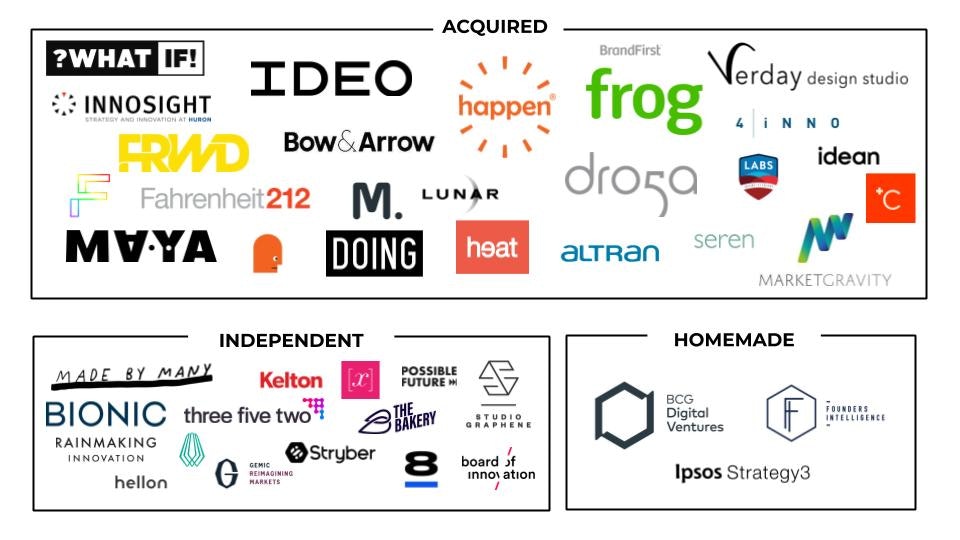Fredrik Silfver, cofounder and chief technology officer of Above, the Swedish innovation consultancy, has a very hands-on background in coding and UX design. But he is also keen to make corporate teams more creative. Start a sci-fi book club to get inspiration, start an internal blog to share ideas, learn from the way children pay no attention to what is and isn't possible — these were some of the tips Silfver shared with Sifted.
What will the innovation industry look like in 2025?
My observation is that society, technology and the environment are becoming more complex. We are rapidly moving online not only for work but also for socialising. Technology with AI is making leaps every quarter and resource consumption is starting to limit growth in some areas.
I would bet on three major themes:
- Artificial intelligence
This summer I think we saw baby steps towards general artificial intelligence with the release of GPT-3 from OpenAI. An AI that learned math on its own by reading Wikipedia articles without anybody asking it to is... interesting. We’re only starting to scratch the surface of the next big paradigm shift where topics like ethics in AI and inclusive AI training data are becoming relevant innovation areas, together with the endless possibilities for new types of applications and jobs. - Sustainability
Innovation will become more urgent when the planet starts to scream for humanity to shape-up. With Covid-19 we now see that we actually can adjust swiftly if the threat is urgent enough. Sustainability innovation will be about how to establish an urgency mindset and come up with attractive concepts that save resources, including money. - Communication experience
People need a new way of getting together. The look in people’s eyes after a three-day online conference is dangerous. It’s time to move out of the online meetings, and endless calls where people are scrolling Amazon in the background. The incremental innovation with more advanced wearable audio products is moving us, clearly, forward. What currently excites me is where Neuralink’s communication brain implants will be in five years.
What is your best communication or corporate storytelling tool when trying to get buy-in from corporations?
Nobody would fully admit it, but getting buy-in and traction in corporations is mostly about politics and less about genuinely great ideas. Politics ends up being about influence and, therefore, enterprise influencers are significant but informal stakeholders. However, influencers need platforms to evangelise perspectives to become impactful. Platforms that don't exist or are simply just too weak.
Getting buy-in and traction in corporations is mostly about politics and less about great ideas.
It's surprisingly easy to set up an internal WordPress blog. Start sharing your team's thought-leading content with blog posts, concept videos, and prototypes. Build an internal newsletter and drive traffic to your little internal site. Create videos, functional prototypes, and invite to demonstrations internally to get attention. Try not to let perfection get in your way, let people use their imaginations to fill in the gaps. Sooner or later, you will have the right people showing up. Think about it as internal marketing.
How do you challenge yourself and your team to 'think outside the box'?
Personally, exploring the imagination of my daughter with her wild approach to feasibility has led me to quite a few "why not" situations that I didn't see coming. Another fun way of getting inspired and thinking outside the box is to actually read science fiction. Get inspired together and start a book club.
A fun way of thinking outside the box is to read science fiction. Get inspired together and start a book club.
The imagination of others about future alternative societies and technology advancements is actually rocket fuel for starting to link today and multiple alternative futures together.
What is currently NOT working in corporate innovation?
Lack of creative leadership. Corporate innovation tends to focus on structure, process and management rather than culture, talent and passion. It's an inclusive and convenient myth that anyone can innovate and come up with great paradigm-shifting concepts if random people just show up in the same room and start writing post-its.
Successful, structured innovation requires creative talent with industry intuition, experience, and understanding of where the problem space is moving. Without that, ideas often tend to be obvious and shortsighted. Organisations often fail to create and maintain enough talent gravity to get moving with innovation on their own. At Above, we spend quite some time coaching leaders in both small and big organisations building self-propelled creative cultures to get their creative flywheel spinning.
What advice would you give to a new Head of Innovation? What do they need to get right from day one?
- Prioritise momentum, not alignment
Start nurturing a creative culture where you encourage your team to challenge each other and support them in creating low-cost, low-distraction, and low-risk experiments fuelled by individual passion. Protect your creatives from creativity-killing alignment discussions. Remove team FOMO, help them understand these are experiments. Get the gear they need to experiment and allow some slack. Sometimes it's VR goggles, sometimes it's a laser cutter, sometimes it's deep learning hardware. You probably already know what's right for your team. The idea is that by building a playground for creativity — the magic will start to happen almost by itself. - Content is king, distribution is god
When your team has started to spend time on the more future-looking experiences, prototyping, and firing bullets, it’s time to communicate what’s going on. Create videos, functional prototypes, and invite demonstrations internally to get attention. Try not to let perfection get in your way, let people use their imaginations to fill in the gaps. Get buy-in and start firing cannonballs with higher ambitions. - Practice the art of doing, not talking
A well-balanced load between urgent and non-urgent activities isn't something that you magically wake up to one day. It comes only by design. You have to be disciplined and decide how you and your team should spend time and resources. Set aside some time for non-urgent forward-looking thinking.
How would you describe a post-Covid consumer?
There will probably be the consumers that no matter what, will try to continue with life just as before for different reasons. Commuting to work with cars, shopping in malls, watching sports together, and so forth. Going to the office to see people and to the mall to enjoy shopping will become expensive entertainment-focused experiences.
The new resilient post-Covid consumer is smart and dynamic, demanding, and an impatient next-generation digital nomad with the tiny twist of not travelling as much. Online services and distribution will get a serious upgrade to support people wherever they are. The new impatient consumer expects their online shopping experience for pretty much anything to be no more than a few hours in total; from checkout to delivery at their doorstep. Just looking at the high-quality telemedicine services available today, from online doctors, psychologists and dentists(!) hints towards what to expect. The post-Covid consumer will demand to be able to fully participate in society digitally with online voting, schooling, and the list goes on.
What is the best advice about innovation (or the innovation industry) that you have been given?
Learn from success, not from failure. People are obsessed with the concept of failing. Failing fast, failing gracefully, failing often. Corporations with multiple portfolios, ranges and market insight can build, should identify, and focus on their recipe for success. What are we doing and what is the behaviour we are showing when we are successful? Again, innovation is about culture and behaviour.
What book has been most helpful to you in thinking about corporate innovation?
Safi Bahcall's Loonshots is a great book about incentive dynamics when organisations are growing. His idea of how all groups will shift from innovative to political — just like all liquids will freeze — is a great way to explain incentives connected to innovation in corporations.
Another one of my favourites is The Culture Code by Daniel Coyle. In his book, he decodes the essence of building high performing, engaged teams, and high-purpose environments filled with small, vivid signals designed to create a link between the present moment and a future ideal for team culture.
Is there really a benefit in bringing in an external innovation team rather than doing this in-house?
There are three main benefits:
- Refreshing incentives
External teams always have to deliver new and fresh creativity, project after project, to not get replaced by another agency or an in-house team. Top-performing external teams are judged on the level of creativity and implementation feasibility combined. That creates an intensive drive to not come back too novel or crazy ideas. - Fastlane to talent
Building a relationship with one or several agencies gives you access to specific hands and brains depending on the project being explored. Ramping up someone internally to do, for example, AI prototyping for a single project is simply not a good idea. Most external teams can shuffle around priorities if the opportunity is interesting enough to get started within a week or two. - Infused culture
Working with an agency allows you to adopt and get inspired by how your external innovation team does things. Make sure that your own team integrates with your hired external masterminds to learn about new ways of working.
What is the biggest mistake you've made related to corporate innovation?
Underestimating the need to support and help out decision-makers when ideas get traction. I’ve seen many great concepts get slashed by opinions or because of product managers’ aversion to risk-taking until pretty much nothing novel is left.



